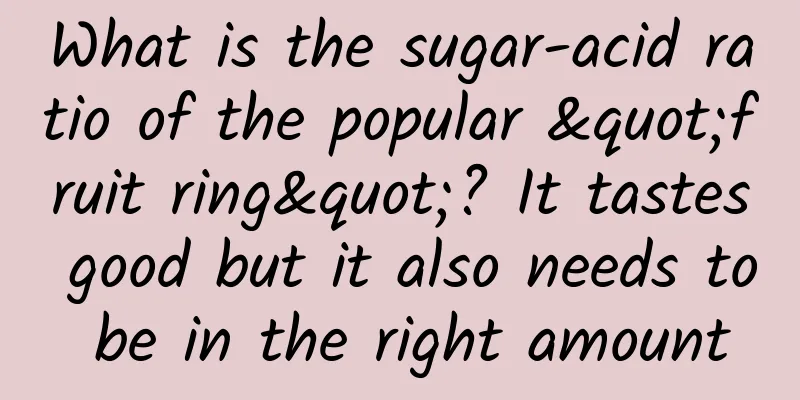What is the sugar-acid ratio of the popular "fruit ring"? It tastes good but it also needs to be in the right amount

|
As summer approaches, the dazzling array of fruits in supermarkets is becoming more and more eye-catching. Recently, a friend sent me a paper package of a Baba orange, on which was written "Golden Sugar-Acid Ratio - 17.5°". In fact, when we go to the fruit store to buy oranges, we can also see such eye-catching words on the packaging, and even some brands of juice will promote the concept of sugar-acid ratio. What exactly is this sugar-acid ratio? Let's uncover it together. The golden sugar-acid ratio of the Babagan orange packaging is 17.5° (Photo source: provided by Zhai Guoqing; reprinting may cause copyright disputes) 01 Sweetness and sourness Sugar and organic acids are nutrients in fruits and are also the main flavor substances. Whether a fruit tastes sweet or not has a lot to do with the type and proportion of sugar it contains, and the same is true for acid. Different types of acids also give fruits different flavors. Some people think that when buying fruit, they should buy fruit with a high sugar content so that it tastes better. Some even use a sugar meter when buying fruit. However, sugar is not the only substance that determines the taste of fruit. Studies have shown that the sweetness and sourness produced by sugar and organic acids, respectively, are the most important taste sensations of fruit. The sweetness of fruit is affected by the type and amount of sugar contained in the fruit. Different types of sugar have different sweetness sensations when eaten. This results in some fruits, although they have a high sugar content, not being as sweet as fruits with a low sugar content [3]. The organic acids in fruits can promote the activity of our digestive glands and improve appetite. Different organic acids have different degrees of sourness, so the type, composition and content of organic acids directly affect the sourness of fruits. Studies have shown that delicious peaches have high sugar content and low acid content, and the sugar-acid ratio is relatively high, while delicious strawberries also have high sugar content and high sugar-acid ratio. 02 Who is “comparing” with whom Different fruits contain different types of sugar and acid. For example, sweet cherries mainly contain glucose, fructose and sorbitol , of which glucose accounts for the highest proportion, reaching 41.7%-51.2%, but it is fructose that determines the sweetness ; and the sour substance is mainly malic acid , accounting for 94.2% . However, sweetness and sourness are not a simple superposition of taste, but a combined effect, so it has become a key factor in measuring taste. The sugar-acid ratio, as the name implies, is the ratio of sugar to acid . The sugar in the sugar-acid ratio refers to the soluble solids in the fruit (mainly the soluble sugars, such as glucose, fructose and sucrose , etc.), and its content can be determined by measuring the refractive index of the sugar aqueous solution; and the acid refers to the titratable acid that can be measured by chemical titration ( generally including malic acid, citric acid and tartaric acid , etc.), and its content can be determined by titration. Image source: provided by Jiuyi ( reprinting may cause copyright disputes ) As people pay more and more attention to the taste of fruits, more and more research is being done on the sugar-acid ratio. People have found that the sweet and sour flavor of fruits is mainly determined by the sugar and acid content and their ratio . The following introduces the relationship between the sugar-acid ratio of several fruits and juices and their flavors: ▶Pear Pears with high sugar content and medium or low acid content taste better; while pears with high acid content do not taste good regardless of their sugar content. The better-tasting snow pear has a sugar-acid ratio of about 115, while the Crown pear has a sugar-acid ratio of about 105, which makes it delicate and sweet [3]. However, pears of different varieties and regions have different sugar-acid ratios. Pear juice made from Dangshan pears is most refreshing when its sugar-acid ratio is 30-40; if the sugar-acid ratio exceeds 50, the taste decreases [5]. ▶Apple For fresh Hanfu apples, the sugar-acid ratio is between 60-80, and the taste is moderately sweet and sour, with excellent flavor. [4] Juice made from Red Fuji apples has a sugar-acid ratio of about 80, and tastes the best. [1] ▶Citrus Research by Zhou Yongbin et al. shows that when the sugar content is sufficient, citrus fruits with a sugar-acid ratio of more than 12 tend to taste sweet [8]. The sugar-acid ratio of Wogan is around 17 and tastes sweet and refreshing, while the sugar-acid ratio of Chunjian is around 12 and tastes sweet and sour [2]. According to an article on orange juice, when making orange juice, when the sugar-acid ratio is adjusted to 21, the orange juice produced is beautiful in color, tastes sweet and sour, and has the aroma of orange [9]. For most fruits, the sugar content changes slightly, but the acid content changes significantly . Therefore, the acid content of the fruit is an important factor in determining the sugar-acid ratio. According to the standards of the United States Department of Agriculture, the sugar-acid ratio of Class A orange juice is 12.5-20.5 [7]. Considering the importance of sourness in oranges, many businesses choose fruits with a acidity of around 0.68% and propose the concept of the golden sugar-acid ratio to indicate the optimal ratio of sugar to acid, such as the 17.5 commonly seen on the market. But we cannot ignore that after fruits are picked from the tree, they will go through a ripening process . During this process, some fruits will convert the starch they contain into soluble sugars and may also lose water, thereby changing the sugar-acid ratio of the fruit and affecting the flavor of the fruit. The flavor of a fruit is the overall feeling produced by the stimulation of the human sense of smell and taste . In addition to the sugar-acid ratio, the aromatic substances in the fruit also affect the taste of the fruit. For example, the unique flavor of coconut and banana also gives the fruit a certain appeal. And everyone has different tastes, and the favorite aromas and acceptable sugar-acid ratios are also different. Banana (Photo source: provided by Jiuyi; reprinting may cause copyright disputes ) 03 Delicious fruits with the right sugar-acid ratio, but not "the more the better" Even if the ratio of sugar to acid is right for fruits and juices, more is not necessarily better. The Chinese Nutrition Society recommends consuming 200-350 grams of fruit per day . It should be noted that fruit is healthier than juice. It is recommended to eat fruit first and drink juice in moderation to avoid excessive sugar intake. Excessive sugar intake not only makes it easy to gain weight, but also increases the risk of chronic diseases such as diabetes. Therefore, even if fruits and juices are sweet and sour, considering the sugar content, it is best to eat in moderation. References: [1] Zhang Dongjing, Yuan Yuxin, Yuan Weifeng, Gao Guizhen, Zhang Xingtao, Jin Bingbing. Research on the processing technology of Red Fuji apple suspension juice beverage[J]. China Fruit and Vegetable, 2015. [2] Lin Mei, Yao Zhoulin, Wang Tianyu. Study on the content and characteristics of sugar and acid components in 8 hybrid citrus varieties [J]. Journal of Fruit Science, 2021. [3] Zhu Dazhou, Tu Zhenhua, Feng Lin, Chen Zaoyan. Comparative study on the fruit quality of Crown Pear in Gansu and Hebei[J]. Journal of Food Safety and Quality, 2017. [4] Gong Yuanjuan, Zhang Jianpeng, Zhang Yan, Ning Xiaofeng. Optimization of preservation conditions of Hanfu apples stored in natural cold source fresh-keeping warehouse[J]. Journal of Shenyang Agricultural University, 2016. [5] Zhang Dongjing, Yuan Yuxin, Yuan Weifeng, Gao Guizhen, Zhang Xingtao. Optimization and preparation of Dangshan pear suspension beverage[J]. Journal of Jiamusi University, 2016. [6] Wu Xiaohong, Chen Baohong, Li Xiaohua. Determination of total acid and total sugar in citrus fruits [J]. Food Research and Development, 2012. [7] United States Department of Agriculture, https://www.usda.gov/ [8] Zhou Yongbin, Cai Ying, Hu Shulan. Relationship between sugar and acid content and flavor quality of citrus fruit[J]. Acta Horticulturae Sinica, 2021. [9] Li Na, Liu Yingping, You Yina. Research and development of orange juice product formula[J]. Food Science and Technology, 2015. Author: Jiuyi Member of China Science Writers Association Reviewer: Wang Guoyi, Associate Professor of Beijing University of Technology, Chairman of the Elderly Food and Health Committee of Beijing Food Society, Postdoctoral Fellow in Nutrition and Food Safety of China Agricultural University Produced by: Science Popularization China Produced by: China Science and Technology Press Co., Ltd., China Science and Technology Publishing House (Beijing) Digital Media Co., Ltd. |
<<: Is dopamine, which is so popular, really the "code for happiness"?
>>: Failed Mathematics! It turns out AI is also a student with a weak academic performance...
Recommend
The "pigeon tree" from China has amazed all of Europe
In the spring of 1869, a French missionary named ...
A complete Xiaohongshu traffic promotion plan!
Since May 2019, it has been a very difficult year...
Japan bans reselling of masks! What will be the punishment? What is the current epidemic situation in the country?
The recent epidemic has spread across the globe, ...
Christmas marketing strategy for booming sales!
This year's shopping season seems to be "...
Rules for Juliang Qianchuan Advertising and Direct Broadcasting
What traffic dividends does Qianchuan Search have...
Jellyfish are cute and delicious? But being stung by them is terrible and can be fatal!
Jellyfish salad is refreshing and appetizing, and...
Benefits for Android users: Ten major improvements in Google Android N
The online version of Forbes recently wrote an ar...
How to get an invoice for Tencent advertising recharge? Invoice application guide!
How to apply for an invoice 1.How to get the invo...
If you have 4 symptoms after a meal, beware of pancreatic cancer! Especially for this type of people
The pancreas Compared with the heart, liver, sple...
The U.S. Navy accelerates unmanned production and produces the second Stingray to provide air support for the E-2D
On August 18, 2021, a U.S. Navy E-2D Hawkeye airc...
Introduction and tips for Baidu e-commerce promotion!
E-commerce store promotion is a marketing product...
Hackers vs. smart cars: Count the models that failed
Cars are no longer just a means of transportation...
iOS 18 new features only support iPhone 15 Pro and above!
There are still two days before the release of iO...
Personal understanding of the stack in function calls
This is my first blog. Due to the needs of the co...
China Mobile's 4G penetration rate is four times that of 3G
According to relevant statistics, in the first fou...









